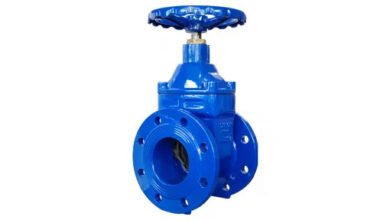Types of Industrial Ball Valves & Designs

Housing Assembly
-
One-Piece Ball Valve
The body of a one-piece ball valve consists of a single-piece cast that houses the ball valve’s internal components. This eliminates the possibility of fluid leakage. One-piece ball valves are the cheapest valves and have a smaller bore. Ball valves welded into one piece are more common, but they cannot be dismantled for cleaning or repair once damage, so they are only use for applications with a low chance of particle build-up, and where sanitation is not a major concern. Screwed one-piece ball valves, on the other hand, can be clean, service, and repair, but dismantling them requires special tools.
-
Split Body Ball Valves
Valves with split bodies are assembled on the sides of their balls. It may be a two-piece ball valve or a three-piece ball valve:
-
Two-Piece Ball Valve
The two-piece ball valve has a housing divided into two pieces that are fitted together. One-piece contains the ball and a connection to one end, while the other piece holds the internal components together and has a connection to the other end. This is the most common type of ball valve housing. Both parts can be dismantled for cleaning, maintenance, and inspection, but removing the valve from the pipe is require.
-
Three-Piece Ball Valve
The three-piece ball valve consists of the housing for the internal components of the valve that are attached and held together by bolts. Both ends are threaded or welded to the main pipe.
Typically, three-piece ball valves are use for applications that rely heavily on valves and require frequent maintenance. Their seats and seals can replace routinely by just taking out the valve body without disturbing the two ends. Ball valves with three pieces are commonly found in the food, beverage, and pharmaceutical industries, where sanitation is crucial to safety and product quality.
-
Top Entry Ball Valve
With a top entry ball valve, the internals of the valve can be accessed by simply removing the bonnet on top. It allows in-line maintenance activities (i.e., dismantling, cleaning, inspecting, and repairing the valve) without removing the ball valve from the main pipe.
Ball Design
-
Floating Ball Valves
In ball valves, the floating ball is the most common design. The ball hangs inside the valve and is free to move in a lateral direction when the valve is close. The valve is sandwich between two seats that support and hold it in place. The ball is attach to one end of the shaft in a slot, while the other end is free. The shaft connection to the slot at the top of the ball prevents the ball from moving laterally when the valve is in an open position.
The sealing action is solely dependent on fluid pressure. When a floating ball valve operates, the fluid pressure forces the ball onto the outlet seat, preventing the fluid from escaping. Fluid pressure on the ball and the seats are higher when the ball valve is close.
-
Trunnion Ball Valves
During a trunnion ball valve, the ball is supported by an additional shaft at the bottom, known as the trunnion. It holds the ball in place and limits its movement to its axis. Only the valve shaft can rotate, so the ball cannot move. Trunnion ball valves also have spring-loaded seats. Pressure from the inlet fluid activates the springs towards the ball held by the trunnion, resulting in a tight seal.
Trunnion ball valves are available in small to large diameters, but they are more expensive than floating ball valves. They are able to operate efficiently at a wide range of pressures, and they are ideal for high-pressure applications since the fluid pressure is also dissipate to the trunnions and the springs of the seats. Therefore, they are easier to operate with a lower operating torque or a small actuator.
-
Vented Ball Valve
Vented ball valves are design and operate the same way as regular ball valves, except that they have small orifices drilled into their sides to provide ventilation. When the valve is close, the orifice is directed to the valve’s outlet. By drilling the hole, trapped gases can be vented, which reduces internal pressure inside the valve, preventing leaking, failure, and explosion.
Vented ball valves are use in compress air systems and cryogenic processing, as well as in conveying volatile liquids, and are also refer to as “cryogenic valves” because of their utility in cryogenic processing.

Bore Profile
-
Full Bore Ball Valve
The bore diameter of a full bore is similar to the pipe diameter. The flow area for full bore valves remains the same, so the flow resistance of this type is very low. Due to minimal frictional loss, the pressure drop is low during fluid flow. A high-pressure drop in a piping system makes pumping more difficult. Due to the fact that the bore diameter must match the pipe size, it requires a larger ball size and larger housing, making it more expensive than a reduced bore.
style=”font-weight: 400;”>Full bore ball valves are easier to clean and maintain. An operation called pigging is use to inspect and maintain pipelines. During pigging, a spherical or cylindrical device called a pig is allow to flow in the pipes to detect and remove any buildup without interfering with the fluid already inside. With full-bore ball valves installed, this operation is possible.
Ball valves with full bores are also use to convey liquids with mixed solids when flow restrictions cause a buildup of particles that can eventually separate the liquids flowing through them.
Reduced Bore Ball Valve
Reduced bores have a diameter smaller than the (connection) pipe diameter by pipe size. The actual reduction depends on the agreement between the manufacturer and the customer. The flow area for the fluid narrows at the downstream outlet, so frictional losses are introduced, resulting in a pressure drop. Since the amount of flow discharge remains constant, the velocity increases with a decrease in flow area.
Reduced bore ball valves are more common than full bore ball valves. In applications where product flow rate and turbulence are not a concern and particle build-up is unlikely, they are use. Reduced bores are less expensive than full bores since they require smaller ball sizes and housings. Reduced bore ball valves have a relatively smaller pressure drop than other types of valves.
-
Segmented Ball Valve
Segmented ball valves have a V-shaped notch on the ball. The Segmented ball valves control flow rates well depending on the rotation of the ball. It also has a good shut-off feature. A segment ball valve approaches an equal percentage flow characteristic. When the ball is fully open, the flow rate of the segmented ball valves increases exponentially.
Other Types of Ball Valve
-
Cavity-Filled Ball Valve
The seat of a cavity-filled ball valve fills the gap between the ball and its body. A ball in this way eliminates the possibility of entrapped media or particles building up over time around the ball, which may result in contamination or obstruction of fluid flow. Cavity-filled ball valves are easier to maintain and clean.
In industries where sanitation is crucial, such as the food, pharmaceutical, and bioprocessing industries, cavity-filled ball valves are crucial. Solid-liquid mixtures, such as slurries, can handle by them.
Also, read The Importance of FEP & PFA Lined Ball Valves
-
Multi-Port Ball Valve
Using a ball with an L-shaped or T-shaped bore segmented through its middle, multi-port ball valves can divert, combine, split, or shut off multiple fluid streams. The flow upstream of a multi-port valve can be split into multiple outlet streams. Although it can split a flow, it cannot distribute the flow to its outlet streams at predefined flow rates. You can also combine multiple flow streams into a single stream, or simply change the direction of fluid flow. The schematic diagram below shows possible flow configurations for L-shaped and T-shaped multi-port ball valves.
Aira Euro Automation is a leading manufacturer and exporter of a ball valve manufacturer in Oman. We have a huge range of ball valves available in stock.




